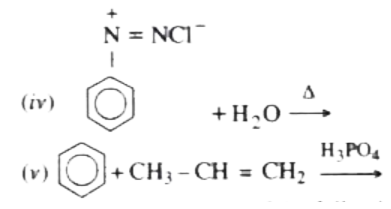Complete the following reaction :
CH3CHOLiAlH4−−−→
To complete the reaction of acetaldehyde (CH₃CHO) with lithium aluminum hydride (LiAlH₄), we will follow these steps:
Step 1: Identify the Reactants
We start with acetaldehyde (CH₃CHO), which is an aldehyde. The reducing agent we are using is lithium aluminum hydride (LiAlH₄).
Step 2: Understand the Reduction Process
LiAlH₄ is a strong reducing agent that can reduce aldehydes to primary alcohols. In this case, acetaldehyde will be reduced to ethanol.
Step 3: Mechanism of Reduction
1. Nucleophilic Attack: The hydride ion (H⁻) from LiAlH₄ acts as a nucleophile and attacks the electrophilic carbon atom of the carbonyl group (C=O) in acetaldehyde. This carbon is electron-deficient due to the electronegativity of oxygen.
CH3CHO+H−→CH3C(OH)H
2. Formation of Alkoxide Intermediate: The attack leads to the formation of an alkoxide intermediate (CH₃CH(OH)H), where the carbonyl oxygen is now negatively charged.
Step 4: Protonation of the Alkoxide
3. Protonation: The alkoxide intermediate then reacts with water (or a proton source) to form the final alcohol. The negatively charged oxygen (O⁻) picks up a proton (H⁺) to become a hydroxyl group (OH).
CH3C(OH)H+H2O→CH3CH2OH+OH−
Step 5: Final Products
The final product of the reaction is ethanol (CH₃CH₂OH), and the by-products include lithium hydroxide (LiOH) and any remaining aluminum species from the reduction process.
Final Answer
Thus, the complete reaction can be summarized as:
CH3CHOLiAlH4→CH3CH2OH
We start with acetaldehyde (CH₃CHO), which is an aldehyde. The reducing agent we are using is lithium aluminum hydride (LiAlH₄).
LiAlH₄ is a strong reducing agent that can reduce aldehydes to primary alcohols. In this case, acetaldehyde will be reduced to ethanol.
1. Nucleophilic Attack: The hydride ion (H⁻) from LiAlH₄ acts as a nucleophile and attacks the electrophilic carbon atom of the carbonyl group (C=O) in acetaldehyde. This carbon is electron-deficient due to the electronegativity of oxygen.
CH3CHO+H−→CH3C(OH)H
3. Protonation: The alkoxide intermediate then reacts with water (or a proton source) to form the final alcohol. The negatively charged oxygen (O⁻) picks up a proton (H⁺) to become a hydroxyl group (OH).
The final product of the reaction is ethanol (CH₃CH₂OH), and the by-products include lithium hydroxide (LiOH) and any remaining aluminum species from the reduction process.
Thus, the complete reaction can be summarized as:
CH3CHOLiAlH4→CH3CH2OH
Topper's Solved these Questions
- ALDEHYDES, KETONES AND CARBOXYLIC ACIDSBOOK - ICSECHAPTER - ALDEHYDES, KETONES AND CARBOXYLIC ACIDSEXERCISE - ISC EXAMINATION QUESTIONS (PART-II DESCRIPTIVE QUESTIONS) (CARBOXYLIC ACIDS)
99 Videos
- ALCOHOLS, PHENOLS AND ETHERS BOOK - ICSECHAPTER - ALCOHOLS, PHENOLS AND ETHERS EXERCISE - ISC EXAMINATION QUESTIONS
25 Videos
- APPENDIX II ( TYPICAL CONVERSIONS)BOOK - ICSECHAPTER - APPENDIX II ( TYPICAL CONVERSIONS)EXERCISE - AROMATIC CONVERSIONS
98 Videos
Similar Questions
Complete the following reaction :
CH3CHOCH3MgBr−−−−−→___H3O+−−−→__
View SolutionComplete the following reaction :
CH3CH2CHOOH−−−→
View SolutionComplete the following reactions :
(i) (CH3)2COLiAlH4−−−→
(ii)
(iii) CH3CH∣OH−CH3+PCl5→ (iv)

View SolutionComplete the following equations :
CH3CNLiAIH4−−−−→
View SolutionThe product P of the following reaction is
CH3−COOHLiAlH4−−−→SOCl2−−−→K14CN−−→H3O⊕−−−→P
View SolutionComplete the following reaction:
CH3CH2COOHP,Br2−−−→[A](i)alc.KOH(excess)−−−−−−−−−−−−−→(ii)H+[B]
View SolutionComplete the following reaction:
CH3CH2COOHP,Br2−−−→[A](i)alc.KOH(excess)−−−−−−−−−−−−−→(ii)H+[B]
View SolutionComplete the following reaction:
CH3CH2COOHP,Br2−−−→[A](i)alc.KOH(excess)−−−−−−−−−−−−−→(ii)H+[B]
View SolutionComplete the following reactions : CH3OCH3+PCl5→
View SolutionComplete the following reaction :
(CH3CH2COO)2Caheat−−→
View Solution
